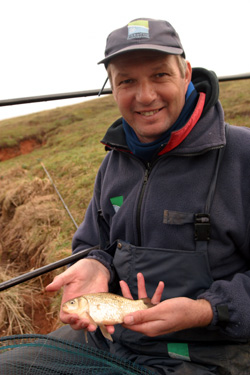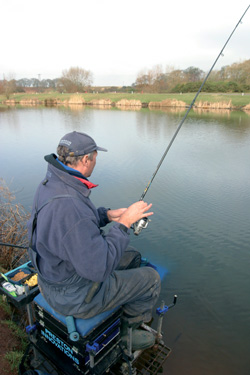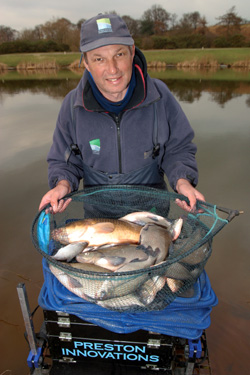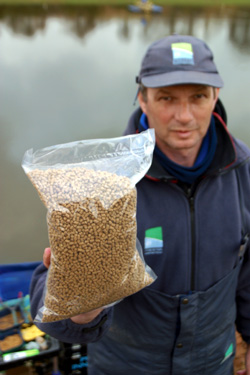Pellet fishing is without doubt one of the most deadly commercial water tactics and as the water starts to warm, pellets take over from the winter maggot and pinkie approach. Preston Innovations-backed legend TOM PICKERING took us to Hallcroft Fishery to show us how to get the best from the little brown fellas.
TROUT pellets were originally made for feeding salmon and trout fry as this feed contains high protein and oil levels; ideal for rearing these species. Anglers soon cottoned on to the fact that trout pellets made an excellent feed for coarse fish as well and would feed fry intended for commercial waters on these high oil offerings. This bait became superior to any other and rightly so; what bait could be more natural to a fish raised on pellets, than pellets? Some fisheries started to ban the use of these high oil baits as owners claimed fish were having difficulty digesting them – this lead to the development of the more ‘fish-friendly’ carp pellets.
Carp pellets are simply a low-oil-content version of trout pellets that are supposed to provide coarse fish with a more balanced diet. Many commercial waters, including Hallcroft, now state the only pellets that may be used are carp pellets and several fisheries insist that you purchase their pellets on site to avoid any confusion.
Where To Fish
Knowing where to target fish in your peg is one of the most important aspects of match fishing. Some venues respond well to a short pole approach when the water’s warmer, while others, particularly at this time of year, respond best to a long pole approach.
If you’re unfamiliar with a venue, watching the best anglers is a great way of finding out where to fish. All I do is to single out five or six good anglers on the venue and watch what areas of the swim they target. See how far out they fish and watch for any other area they plumb up because these ‘venue experts’ know where the fish will be at certain times of the year.
 |
| When it’s cold every fish counts. |
Your plummet is a very essential item of tackle and making sure you search out the swim will allow you to create a mental picture of the bottom. Here on Moat Lake at Hallcroft, there’s a steep slope that flattens off at around four metres, then it’s identical within inches, no matter how far out you go. However, this doesn’t mean you should just find the deepest water and fish there as I’ve had times when I couldn’t catch at 11 metres, but I bagged up at seven metres in the same session…work that one out!
Make Every One Count
When the water’s still a bit cold, you never know what sort of weight you’ll need to win, so it’s important that you make every fish count. Once you hook a fish, there’s no need to rush, just take your time and they should all end up in the net. It’s important to keep your pole low when you ship back because this will allow you to watch your elastic so you’re able to judge what the fish is doing. A roller positioned in the correct place is a great help as it allows the shipping to be smooth and also prevents you spilling the contents of the pole pot when you feed.
Here at Hallcroft the fishery owner takes a reading of the lake’s temperature every day, so it’s a little easier to judge how each will fish. You can then use this information to your advantage. For example, if the lake’s temperature is around 2°C, then it’s likely to fish hard, but if the water’s 6°C or more, it’s possible that you’ll need a bigger weight to frame.
Following Trends
Commercial waters in particular have their ‘in’ baits and they usually change throughout the season. Take last winter as an example; meat was the number one bait here and I caught loads of carp on it, but this year corn and pellet have been far and away the better baits. Talking to the venue expert is usually the most accurate way to find out about this, but fishery owners and other regulars usually know the score, so do a bit of homework before you get out on the bank.
Bomb Tactics
The bomb plays a big part in my cold-water approach because it usually results in a couple of quick fish at the beginning of the match. Hallcroft is similar to many other venues in that you face anglers on the far bank, so halfway between you and the peg opposite is the maximum distance you can cast. This means you usually chuck into the middle of the lake and that’s often the deepest part of your swim.
I’ve noticed that the bomb catches far more fish on windy days than it does on calm ones and I think this is for the following reason. A wind is often accompanied by tow on the water and the tow’s always less at the bottom of the lake than at the top, so that’s where the fish prefer to sit as they have to expend less energy. On flat calm days a bomb approach doesn’t seem to be as effective because fish will sit further up in the water – that’s my theory anyway!
If there are fish on the bomb line you’ll usually get liners to indicate they’re there, but if you don’t it’s usually a sign of no fish. So, although it’s definitely a line you need to fish, don’t end up spending too long on it if you’re not catching or getting indications regularly.
I think it’s very important to feed when you’re fishing the bomb although I know most simply cast the rig into the lake and wait for the tip to go round, but I don’t have enough confidence this way. To make it a winning method for me, I will always introduce two pouchfuls of corn around the area I’m fishing and cast my single grain hook bait on top of that.
 |
| Tom prefers to fish with a plummet rather than a standard bomb because it makes a very loud ‘plop’. |
Bomb Rig With A Difference
I fish my bomb rig a bit differently to anyone else I’ve seen and I actually favour a plummet instead of a standard bomb. There are two reasons for this. The first is that the plummet makes a very loud ‘plop’ when it hits the water and the second is the way the flat-bottomed plummet sits on the bottom. The line runs through the eye and actually sits up off the bottom so there is no resistance when a fish picks up the hook bait, resulting in the tip flying round.
My bomb rig is again very simple and I prefer a running set-up because it’s both safe and effective. The main line is 6lb Preston Direst Mono that’s tied to a Drennan Swivel Bead – the 14” 0.13mm Preston Powerline hooklength is attached to the other end. My only hook choice for this style of fishing is a size 16 Preston PR24 which I’ve found perfect for all sorts of different applications. I like to use a hair rig for corn fishing and I’ve found that you seem to catch more fish this way than straight-hooking the bait. The plummet is attached to the line via a link clip and swivel and is stopped by the Swivel Bead.
Pole Rig
I have just targeted one area on the pole today, but once the water starts to warm up even more I will fish two areas to get the most from the peg. My rigs are always very simple and for fishing with pellets I favour the Preston PB13 float, which has a great bristle for this type of fishing, as it’s both thick and very easy to see at distance. I favour a 4×16 size, but I like to have a 4×14 rig assembled for flat calm conditions.
The rig consists of a bulk of No8s and two No10 droppers between that and the hook. My first shot is situated 10” from the hook and I believe this is very important. I don’t think a fish swims to the bottom to pick the bait up; it will sit off the bottom away from the bait and suck it up. Because my first shot is situated 10” away from the hook, the hook bait rises straight off the bottom into the fish’s mouth with very little resistance, whereas if there was a shot in between, that would prevent the bait rising naturally.
The main line I use is 0.17mm Preston Powerline and the hooklength is 0.13mm diameter of the same material, which many of you frown upon because it’s so heavy. I can’t see the advantage of fishing too light as there are some very big fish in here and I’d rather sacrifice catching a few skimmers in favour of landing a double-figure carp if I hook one. If you think about it, we used to use the old Bayer line and 1.7lb breaking strain had a diameter of 0.13mm… just think about that!
Preparing Pellets
Using the correct pellets is half the battle as well and here at Hallcroft you have to use their feed pellets, but you can use any hook pellets you like and it’s noticeable that some hookers are better than others. It’s best to look around for different types and find one that YOU are happy using.
To prepare my hookers I’II always use a pellet pump as these suck the air straight out of the pellets, making every one of them sink instantly. All you then have to do is add the required amount of water to make them as soft as you like.
I find that for this time of year you rarely need any more than a pint of bait for feeding and the feed pellets I use are already sinking ones, but I like to make them soft by soaking them in water once I get to the bank. It’s important not to add too much water otherwise they’ll go mushy and be unusable. I simply soak the pellets for 10 minutes then drain all the water off and leave them to absorb the remaining moisture. Although the feed pellets are designed for that purpose, I’ve had times when I could only get a bite with a feed pellet on the hook.
I will always have two types of feed pellets with me. The first is the standard 4mm size and the others are micros. I find that if I’m catching skimmers more than anything else, micro pellets are better.
Feeding too much bait results in fast bites, which often means you miss the majority and the bites you do connect with are often foul-hooked fish.
Feeding Ploy
All my fishing is kept simple and this is reflected in the way I feed my swims. Corn can play a large part as the water starts to warm up, especially on the bomb, but pellet is the only other feed I use. To start a session I will introduce all my bait onto the pole line with a pot. The reason for this is simple – it’s because I want to concentrate the fish in one small area. I’ll then leave this line for one hour and fish the bomb while I let the fish find the bait. If I’m catching on the bomb I’ll stay on it, but if not I will go on the pole.
It’s important not to feed the pole for at least one hour after the initial load and usually you’ll find that your first put-in will result in the float burying with a positive bite. However, if this isn’t the case, I will give it 10 minutes and have a look back on the bomb line if no fish materialise. If I do catch a fish on the first drop-in, I will stay on that line because there will often be a few fish in the area.
I know many anglers like to feed via a small pot on their pole, or cup in regularly, but I don’t think that’s the best way to feed, and I make the catapult an essential part of my weaponry. Loose feeding with a catty seems to have taken a back seat in recent years, particularly on commercial fisheries, but I definitely wouldn’t be without one for my open-water work.
The water’s still quite cool, so a careful approach is the best way to go and I like to start off my loose feeding by introducing around 10 pellets every put-in. Loose feeding over the top spreads the feed around, which I believe actually helps to draw extra fish into the peg. Having some bait falling through the swim at regular intervals seems to get the fish interested in feeding faster than potting the bait in and sitting over a bed of feed.
When I initially feed the swim, I will spread the bait over an area the size of my landing net head. This gives the fish a bigger area to settle over and I’ve always found that even if you catapult your loose feed pellets around the swim, you’ll always catch the vast majority of fish over the initial potted feed, so you must line your pot up against a far bank feature when you pot your bait in.
Missed Bite… No Problem
I see plenty of anglers striking very hard when they get a bite, but I really can’t see the sense in this. All I do is lift when the float goes under because I believe the fish has hooked itself when the float fully submerges. Striking hard results in more foul-hooked fish because if you miss the initial bite, and there’s a fish sitting above that one, you’re likely to foul hook it.
Lifting into a bite will mean your bait is still on if you miss it, but often missed bites can be liners or the fish has spat the bait out before you’ve had a chance to strike. If you’re getting indications and they suddenly stop, this can mean a carp has moved into the peg, so just concentrate and you’re usually rewarded with a fish.
Conclusion
 |
| By alternating his lines and letting his feed settle Tom put together this tasty bag of Hallcroft fish. |
As the session has progressed I’ve caught a succession of skimmers, all on small expander pellets, but it has been hard work and has taken a lot of concentration to keep the fish coming regularly. There have been quite a few skimmers in the peg at times and I’ve had a couple pushing the 3lb mark, which are cracking fish to catch, particularly in a match. As I predicted, the swim has gone quiet several times, but because the lake has been flat calm for most of the day, the fish didn’t want to know on the bomb line. I’ve not even had a liner, yet just a week previously I had a succession of fish on the bomb, but the pole line wasn’t so productive, that’s just the way it is.
I’ve kept the swim topped up throughout the session via the catapult, but every time the swim really started to tail off I potted in the feed to concentrate the fish then left it for 10 minutes while I fished the bomb and had a cup of tea. As I said, a lot of the time you’ll catch a fish on your first put-in after refeeding the swim and on most occasions this has been the case. The heavier gear certainly proved its worth today when I hooked a nine-pounder halfway through the session that tore off across the lake. Would I have landed it on a 0.10mm hooklength?
It just goes to show that a complicated approach to pellet fishing is just not necessary as I ended the session with around 20lb of skimmers and bream as well as that bonus carp – not bad for a cold February day.
VENUE FILE
Fishery name: Hallcroft Fisheries
Telephone number: 01777 710448
Fishery owner: Brian Talbot
Where situated: Hallcroft Road, Retford, Notts
Coaching: Jamie Masson offers personal instruction at Hallcroft, call him on 07786 940690 for details
Bans: Barbless hooks only, maximum size 14; no hemp or tiger nuts; no floating baits except on the pole; feed pellets must be bought on site – maximum of one kilo per angler, per match; The Method is banned; maximum of one kilo of groundbait per angler per match, five pints of loose feed (excluding pellets) per angler, per match. Nets must be dipped. Keepnets only allowed in matches. 14.5- metre pole limit.
How to find it: From Retford, follow signs for Hallcroft Trading Estate (north of the town). Once there you’ll pick up signs for the fishery.







